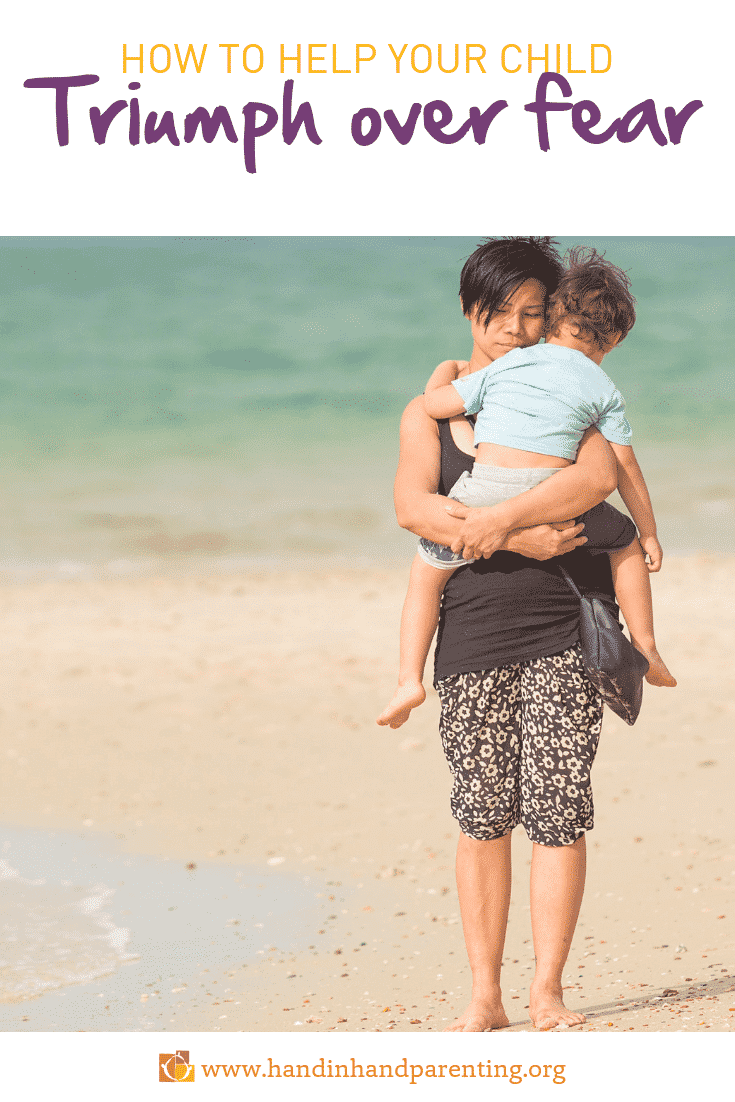
Thunder. Bees. Slides. Broccoli. Escalators. Tests.
There is no shortage of things that can send our child into minor avoidance or full-on terror.
As a parent, we want to help our child triumph over fear, but most often we’re at a loss for what to do. Sometimes the only thing we can think of to help our fearful child is to let them avoid whatever is scaring them. If our child is afraid of dogs, we may choose to avoid dogs when we’re out. If our child is afraid of new foods, we may stick to familiar food choices only.
Face the Fear or Let Them Grow Out of it?
While we may reassure ourselves that they’ll “grow out of it” someday, this often puts us in the position of leaving our child alone on the sidelines or actively helping them avoid what scares them. After a while, either choice leads us down a path of avoiding more and more things as our scared child grows ever more fearful.
It is especially hard when these fears start to interfere with family life. A fear of water may have us skipping pool parties, days at the beach, and even bath time. And, our hearts sink as we watch our child sit on the sidelines while other children run through a sprinkler laughing. We long to help our sweet child, but we also don’t want to push them too hard!
We may try cajoling them with reassurance or even bribe them with treats if they just try to face their fear. But our best intentions often don’t work. At this point, we may feel torn between pushing them to face their fear and just giving up on them. We may even get angry and snap at them for being “ridiculous.”
However, neither forcing our child to face their fears prematurely nor helping them avoid what scares them feels particularly good to us parents! Both leave us feeling powerless to help our child in a kind and respectful way.
How Can I Help My Child Triumph Over Fear?
Luckily, it’s not an either/or issue. As parents, we can take an active role in supporting our child and help them conquer their fears in a powerful, respectful way using the Hand in Hand Parenting Listening Tools.
Here are some ways that you can try now to support your child and help them triumph over their fears.
Increase your Connection with Special Time

A great first step to helping your child overcome their fears is by pumping up your connection with them. The safer and closer your child feels to you, the more easily they can show and shed the fearful feelings they have been holding on to and managing through behaviors like avoidance, aggression, and fussiness.
Special Time is a form of play where you let your child be in charge of your relationship for a set amount of time. It may be anywhere from a few minutes to half an hour. This time together is different from other play times with your child as you will follow their lead (no multi-tasking or phone-checking), shine all of your warmth and attention on them, and do not offer any advice or suggestions on what you do together. Let your child direct the play. The more regularly you can do this, the more often your child can show you what’s on their mind.
Even very young children will find ways to work through what’s troubling them with your attention. Here’s how one young child used Special Time to work through her fear of dogs and here’s how Special Time helped me gain a better understanding of my daughter’s fear of big kids.
You can learn more about the power of Special Time with this free video series and checklist.
How Increasing Laughter and Connection Helps Kids Triumph
Laughter helps release the lighter tensions and fears we have. For children, having a chance to take on the more powerful role, while the obviously bigger and more knowledgeable grown-up takes on the less powerful role can be a boon to their confidence.
This play can be very simple. If your child is afraid of thunder, for example, you might play the “I-hope-no-one-makes-any-loud-or-surprising-noises” game. Said in a playful tone, your child will catch on and give you a loud “boom” or other noise at which you can respond by being playfully startled and then say you hope that it doesn’t happen again (wink, wink). If your child laughs at your silly fearfulness you know you’re on the right track. Keep doing what you’re doing! If you’re not getting laughter, try adjusting your tone, or try another angle, to see if you can find what gets the giggles going.
One parent I know found it helpful to play with her son around his food fears. As his palate choices were shrinking, and mealtime anxiety was growing, she added play to their dinner times. When he fussed and squirmed about the broccoli on his plate, she looked at it with disgust and said, “I hope nobody tries to get ME to eat that. I do not like my broccoli chopped that way!” He jumped at the opportunity to feed her spoonfuls of chopped broccoli which she playfully “gagged” on, tried to spit out, and finally ate with great “disgust.” The amazing part was that after all that laughing he unexpectedly took a bite and tried it himself!
Playfulness can help our children triumph over many fears including hairwashing, separation, swimming underwater, and even balloons!
 Set (small) Expectations and Listen to the (BIG) Feelings
Set (small) Expectations and Listen to the (BIG) Feelings
In helping our children conquer their fears they’re going to need to edge up to them. This is where we as parents can help our children by not pushing them too hard, nor helping them continue to avoid. As we edge up to the fears, Hand in Hand founder Patty Wipfler suggests we act like we have “all the time in the world” to conquer the fear. If we move too fast too soon, we scare an already scared child. While untying the knot of fear can and will take time, the process can move more easily if we remember to go slow.
Our language and tone also make a big difference here. Dismissing our child’s feelings with “Don’t be a baby. There’s nothing to be afraid of,” or enabling them with “I know that’s soooo scary! Let’s not do that,” do not support them in moving forward. To help our child gain confidence, we need to be physically close and have our tone convey reassurance that we’ll keep them safe while we introduce the challenge.
We might say things like:
- “I’m right here with you. I won’t leave you alone with this.”
- “I really think you can do this. I’ll stay with you while you try.”
- “I’m sorry it’s hard right now. I’ll keep you safe.”
On a recent group outing, one of the children in our group was afraid to ride the tram up a mountain. It was the only way to get where our group was going, so the expectation was gently set that she would need to ride the tram up with everyone, and mom and dad would be right beside her. Reluctantly, and tearfully, the girl got on. She cried the entire way up, saying she was afraid of heights. Her mom and dad held her and listened while she sobbed hard. “We’re right here, sweetie,” they told her gently. “We won’t let anything happen to you. You’re safe.” Each reassurance brought more tears as the girl kept her face buried into her mom until they reached the top of the mountain.
Once they were off the tram the girl seemed back to herself, but her parents wondered what the trip back down would be like. However, when it was time to head back their daughter hopped on the tram easily and chatted happily all the way down as if she had never been afraid. It appeared the fear had lifted! Remarkably, about a month later, this same child decided to go on an amusement park “hang glider” ride, something her parents did not expect from this girl who had been so “afraid of heights.”
Not all fears resolve after one listening time like this. For some fears that go deeper, like separation anxiety, it may take many instances of slowly edging toward the fear before you begin to see a resolution. For more examples of how to gently set reasonable limits around fears, check out this story on how a mom helped her son overcome a bee sting trauma that left him refusing to go outside for weeks, and how this mom helped her daughter overcome her sudden fear of going upstairs alone.
Conquer your own fears with Listening Partnerships
Listening to our children’s big, fearful feelings can be confusing for us as parents. We may worry we’re pushing too hard or scaring our child even more as they show us just how scared they are. Finding the right balance of support and challenge is tricky, and we don’t have many models for how to do this.
Through it all, it’s important that you are being listened to and receiving support, too. It’s not easy listening to a scared child. Their wild release of feelings can easily trigger your own anxiety, worry, and even anger. The more you have a chance to take your fears, worries, and upsets about your child’s fearfulness to a listener, the more attentive, warm, and confident you’ll be in listening to your child.
Hand in Hand uses a tool called Listening Partnerships where parents take equal turns sharing their parenting struggles and triumphs without interrupting or giving each other advice. Our understanding of how to support our child well in overcoming their fears can become clearer as we get listened to. You can use this time to explore how it is for you to parent your child, how much you want them to feel safe and secure, how frustrating it is that they’re afraid. You can explore what you’ve tried, what you’ve learned, what’s working, and what’s not working. You can look at how your fears were handled when you were younger. This time to explore and notice your own feelings can give you greater insight into your child and yourself.
Another powerful way to help your child triumph over fear is by asking for support in tackling your own fears. If we’re going to ask our child to step out of their comfort zone, we need to be willing to step out of our own too. It doesn’t have to be the same fear your child has, just pick one that troubles you and get to work on it! In this post, UK Hand in Hand Instructor Steph Parker writes about how she successfully released her fears around going to the dentist through her Listening Partnership. This listening time not only frees us up but also gives us a greater capacity to support our children well.
The listening tools, when used together, are a powerful antidote to the powerlessness we can feel in the face of fear. They can remind us we don’t have to stay stuck in fear with our child nor push them to conquer their fears on their own. Instead, we can use these tools to gently, lovingly, and patiently lead our child through their fears and back to their natural state of confidence and curiosity in the world.
If you're ready to tackle fear and build confidence with the support of an experienced Hand in Hand Instructor, join Michelle in her next Starter Class or schedule a free “get to know you” session.
Does your child have sleep fears? Helping Your Children Sleep is an online class that will help you pinpoint fear and address it supportively.

